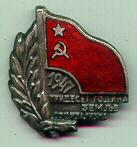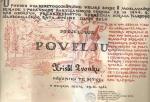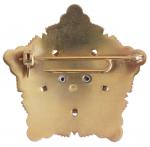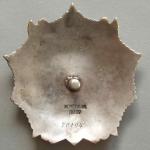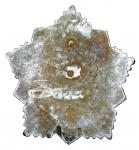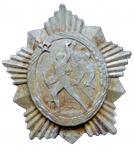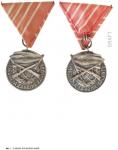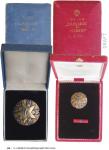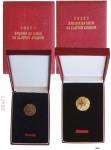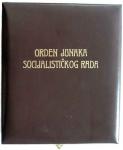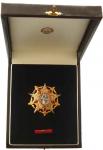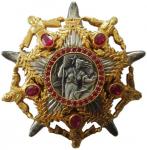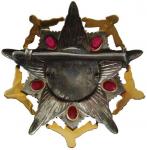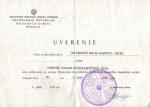
wlodzimierz
For Deletion-
Posts
559 -
Joined
-
Last visited
Content Type
Profiles
Forums
Blogs
Gallery
Events
Store
Everything posted by wlodzimierz
-
Gentlemen, Yesterday took place 10th auction at Serbian Numismatic Society (SND) in Belgrade. Online catalog can be seen at http://www.snd.org.yu/aukcija/ Prices realised had been listed today on the SNS website: http://www.snd.org.yu/aukcija/cene.html Take a look, some prices went very high (Lot 382) Maybe this is only this time, but I couldn't find mayn TOP orders on auction, much less as yaer ago where you could buy Order of Hero of Socialist Labor, 2 Orders of National Liberation (one with award document), Order of Yugoslav Star,... Hopefully we will see some of TOP YU OMDs next time. What is your opinion about OMDs offered for auction and realised prices? waldemar
-
Yugoslavia Order of National Liberation
wlodzimierz replied to Anatoly13's topic in Southern European & Balkan States
Anatoly, I'm convinced that your order 'coverted by ZIN Kovnica' is genuine one. I saw today almost identical order with low number 1xx at serious Dealer in Vienna, he guaranteed that this is genuine order. Congratulation Anatoly best regards waldemar -
Yugoslavia Badge October Revolution 1917
wlodzimierz replied to wlodzimierz's topic in Southern European & Balkan States
Size: 4cm width and 4cm high. waldemar -
Yugoslavia Badge October Revolution 1917
wlodzimierz replied to wlodzimierz's topic in Southern European & Balkan States
Gentlemen, if you look at revers you will find that this badge was gilded, in some parts you can see it. Interesting is that this badge has design very similiar to those of Order of Partisan Star 1st or cl. There are the same symbols: red star placed on gilded laurel wreath. The differences are: sickle and hammer and the date 1917. The sickle and hammer was not common in YU OMDs only order of labor but only 2nd and 3rd class have sickle and hammer on it. Medals for Labor has sickle and hammer and the last one is medal for military merits where on some medals sickle and hammer is wrongly placed on banner. The lack of year 1917 is clear. I think that at least some of participants of Meeting in Jajce on 29/30 November 1942 (Tito and most important people of that time), where the design for Order of Partisan Star was made, the design of this 1917 badge was known. compare yourself: -
Yugoslavia Badge October Revolution 1917
wlodzimierz replied to wlodzimierz's topic in Southern European & Balkan States
I think that commemorative badge refers from time perspective to particular event in the history. Thus two facts must be fulfilled: Originated event: in this case Soviet October Revolution 1917 Time perspective: normaly you will see xx years of ?, or time interval 1917 ? 1947. In both cases is clear we are referring to xxx event from yyy time perspective. The second point is not fulfilled it means that there is no time perspective and therefore I think that this is not commemorative badge. You can tell me look at ?Partisanska Spomenica? there is too only one date: 1941. But this is not the same case. ?Partisanska spomenica? founded in 1941 was instituted as official award of very high rank with privileges comparable (the same) as bearer of Order of National Hero. ?Partisanska Spomenica? was not designed as commemorative badge, it becomes one after 1946. In my opinion this badge is definitively not commemorative badge, it was maybe was an order similar to ?Partisanska Spomenica?, but not commemorative badge. Thank you Anatoly for comments. waldemar -
Yugoslavia Badge October Revolution 1917
wlodzimierz replied to wlodzimierz's topic in Southern European & Balkan States
Gentlemen, last our information was that this badge was made by IKOM and was awarded to Yugoslavian Participants of 1917 October Revolution. "...Time of issue would be just after the war, in 1947, on the occasion of the 30th Anniversary of the October Revolution.". What was disturbing in this hypothesis is lack of year 1947 on the badge, usually in commemorate OMDs you will see two dates: the date of event and another date or number what is the time past from that event or years passt. On this badge there is only one date 1917, I my opinion it can not be commemorative badge. To undermine my position I'm posting a real Yugoslavian Badge issued in 1947 to commemorate the 30th Anniversary of the Soviet October Revolution. As you can see red enameled flag with small 5-pointed golden star and sickle and hammer, a laurel branch and inscription "1947 - 30 Years of the Country of Socialism.". I'm convinced that this badge was issued to commemorate the 30th Anniversary of the Soviet October Revolution. The main questions concerning the badge with year 1917 are the same: who issued this badge, who got it, what was the purpose, when and how many such badges were issued? As we know during the October Revolution 1917 there was Yugoslavian organisation within soviet communist party, this members like Comrade Walter fought in October Revolution. I think that this badge is somehow connected to those events and time.I'm not convinced that this is Yugoslavian production, it has design of early soviet badges. I don't know who issued this badge but it was definitly not the badge struck in 1947 to commemorate the 30th Anniversary of the Soviet October Revolution. What is your opinion? waldemar -
Gentlemen, the question if there were Order of Republik 1st class with star made from red enamel was most dominant question in last two weeks. Anatoly and I made additional and deeper researches and outcome is: yes there were such orders. It is common opinion of many experts we have contacted. To be fully convinced we are looking for document, photo where we could see this order. It was for great surprise to learn that there were orders with red enameled star not only 6 torches but there was one type with 5 torches!!!. What complicate our hypothesis that such order were done at the end of communism. In the case of order presented above we can suppose that this order was made in last period of communism, where basis part of order from 2nd class was used to produce 1st class order. We have identified 4 variants of such order. Meantime I found another type of such order, take a look:
-
Yugoslavia Not ready Order of National Liberation
wlodzimierz replied to wlodzimierz's topic in Southern European & Balkan States
Thank you Milan for this very interesting information. As far I know forgeries of this order appeared on the market in 1990's. Namely, a certain quantity of the inside parts of the order had been found at IKOM, and someone made the false outside parts by casting. So the "semi-forgeries" appeared. Later also appeared the "full forgeries", those which had inside AND outside parts casted. Could you show us your "CURIOSITIES"? all the best waldemar -
Congratulation Milan, Very rare, almost not possible to buy order. This type was replaced in Yugoslavia with later type. Some order given to non yugoslavian citizens survived till today. I've never seen box of this order.Is this correct one? Can you post dateiled images of this box? Are you collecting again YU orders? Thank you for sharing Milan. Waldemar
-
Soviet Alexander Nevski
wlodzimierz replied to wlodzimierz's topic in USSR: Soviet Orders, Medals & Decorations
-
Soviet Alexander Nevski
wlodzimierz replied to wlodzimierz's topic in USSR: Soviet Orders, Medals & Decorations
-
Yugoslavia Not ready Order of National Liberation
wlodzimierz replied to wlodzimierz's topic in Southern European & Balkan States
-
Gentlemen, Lately spotted on internet: not ready Order of National Liberation. Seller says that he bought it in IKOM in 1985. As we know Order of National Liberation is normally made from two pieces, the star and on top a relief made from patinated silver. Relief is connected to the star using two rivets. This order is one piece construction, with three round signs on reverse which are made in places where normally two rivets are and screw back. This signs for holes needed for rivets convinced me that in this particular case it is not a new model for one piece construction. I think that this is a fake, if you look at details you will see poor quality many irregularities. Order of National Liberation is expensive; the probability that this order will be fake is very high. This order is not particularly complicated in the production; I think that we will see soon many of new orders with much better quality as this one shown today.
-
Yugoslavia Order of National Liberation
wlodzimierz replied to Anatoly13's topic in Southern European & Balkan States
There is statement in Mr. Rudaz book about Order of National Liberation which were converted by ZIN/ZNB. A relief on top with persons who are greeting liberation is made from patinated silver and rest of order must be made from tombac (first orders). The whole order has two rivet construction as all other types. There is no evidence that this order was once screw back type. Usually you will see remaining parts or signs. Why there are no signs of conversion is hard to explain. From overall appearance I would say that this is this type of order which was mentioned in the literature. Nice and rare order Anatoly, thank you for sharing. waldem@r -
Yugoslavia Medal for Military Merits -
wlodzimierz replied to wlodzimierz's topic in Southern European & Balkan States
Thank you for your comments Gentlemen. Thanks for explanation concerning placing of hammer and sickle; it was not clear to me. I think that in communism, especially if you worked with political symbols each design was controlled more than one time and controlled by more as one person. Such ?error? was not possible. Such ?error? could happen but only if some people wanted to make an ?error?. It could be political provocation which could be interpreted as ?yes we have communism but we don?t take it seriously?. This type of medal, in my opinion, was produced by IKOM, because they mounted this medal in the way that inscription with Latina text was placed as avers. ZIN/ZNB put Cyrillic text on avers. This is only working hypothesis but it seems to make sense. Serbia was more tided to SU as Croatia and that this ?error? is found in medal made by IKOM is in my opinion more as just coincidence. Or was it really coincidence? -
Yugoslavia Medal for Military Merits -
wlodzimierz posted a topic in Southern European & Balkan States
Gentlemen, according to our current knowledge we have two types of Medal for Military Merits. The one with thick rifles (made probably by IKOM) and other type with thin rifles (made probably by ZIN/ZNB). Small star is located on upper part of this medal. There is hammer and sickle in this star, nothing special. But if you look at star on medal with thin rifles you will find that hammer and sickle are like in mirror image. This is unusual if you consider that the image of hammer and sickle was part of soviet identity. This failure, if seen could have serious consequences for designer. Take a look and write you feedback -
Thank you Gentlemen, it was incredible personality, just imagine as a 20 years old man/boy you will be imprisoned for years. As a political prisoner he was 12 years in prison and who knows how long he would stay there. In 1941 Kingdom of Yugoslavia disappeared and it was a moment where Tito?s partisans liberated political prisoners in Lepoglavi, Sremska Mitrovica and other prisons. As a young man not knowing if he ever will be outside of the prison if he ever will see green grass and blue sky and what is sense of his life. Under such circumstances many people are broken. He did not give himself up. After 12 years in prison as a 32 old man he has been liberated. After the war he went to schools and became Professor and economical scientist. He started his second life again after the war and was very successfully. RESPECT TO HERO OF THE SOCIALIST LABOR - RADIVOJE DAVIDOVIĆ-KEPA. @All Thank you for this positive feedback to this interesting story. There are many documents some in Radio Free Europe Research about his political activities. I will filter some and put it as a small story in book. @Luka This order belongs to my friend who allowed me to make images and use it in a book.
-
ORDER OF HERO OF THE SOCIALIST LABOR founded in one class only on December 8, 1948. Originally awarded only to the non-military high officials of the Republic of Yugoslavia, mostly to those who could not be awarded with the Order of National Hero, i.e. to those who did not take part in the National Liberation Army led by Marshal Tito, but who had been the leading individuals in the Tito's post War socialist society. From 1945 to 1985 only 114 individuals had been awarded by this order. The first one was Mosha Pijade (famous communist revolution theoretic leader and artist), awarded in 1949; it was given to Tito in 1950, and out of 114 awarded 101 were the highest government and political officials, 5 scientific workers, 4 novelists, 3 economist and 1 publicist. THIS order had been awarded to one out of the five mentioned "scientific workers" - Here is the quotation from the book "Odlikovanja Socijalisticke Federativne Juigoslavije" by Stojan Rudez, published by the Official Gazette of the SFRY in 1987, page 63: ".../Order had been given also to/ five scientific workers (Pavle Savic, Bogdan Brecelj, RADIVOJ DAVIDOVIC, Boris Ziherl and Dragisa Ivanovic)". The mentioned Radovoj Davidovic, whose CERTIFICATE is also shown, had been awarded by this order in 1979, on his 70th Birthday. RADIVOJE DAVIDOVIĆ-KEPA Born in 1909 in Novi Becej (Vojvodina, at that time within Austria-Hungary), was a prominent communist, imprisoned from 1929 till 1941in jails (Lepoglavi and Sremskoj Mitrovica) of the Kingdom of Yugoslava. The prison of Lepoglavi is known during the Kingdom of Yugoslavia as the home to "unwanted" groups - the Communists and revolutionaries were incarcerated there, among them Josip Broz Tito, Mo?e Pijade, Rodoljub Čolaković, Radivoje Davidović, Mihajlo Javorski and others. He was liberated from the jail by Tito's partisans in 1943. After the war he was a high government official, and scientist. - he was professor of the Economic Faculty in Belgrade, and was one of the founders and ex-presidents of the Institute of International Politics and Economics, mentioned also on Internet at: http://www.diplomacy.bg.ac.yu/directors.htm Persons awarded with this high and rare order had many social privileges: villas, private drivers, their children were sent for education abroad etc., and they had therefor be colloquially called the "red bourgeois".
-
Great badge Anatoly, congratulation very rare badge. Some Information from Dinar Nr. 24: "Commemorative Badge ?Partisan of Yugoslavia - Citizen of USSR" Celebrating the 45th Anniversary of the Victory of Soviet Union in the Great Patriotic War, an interesting and quite rare badge had been issued and awarded to the still living Soviet citizens who fought in the Yugoslav partisan forces. Out of those who were taking part in the Tito?s liberation army, partisans, 3074 persons had been awarded with high Yugoslav military orders and decorations. This 1990 commemorative badge was issued in 200 pieces only, instead the originally planned quantity of 400. It had been made in aluminum alloy in oval shape, 35x38 mm, and has inscriptions in Russian language meaning ?PATRIOTIC WAR? on obverse and ?PARTICIPANT OF THE PEOPLE?S LIBERATION WAR OF YUGOSLAVIA? on reverse. On the five-sided aluminum suspension plate there is an inscription in three lines meaning ?PARTISAN OF YUGOSLAVIA, CIT. OF USSR?. This badge had been awarded with a Soviet type order certificate in form of a booklet, and it had been signed not by the President, but by deputy of the Vice-President of the Federal Union of the Soviet WWII veterans, Mr. P. I. Kravcenko. Just a reminder that the old disputes between ?revisionist? Yugoslavia and the Soviet block had not been forgotten completely."



